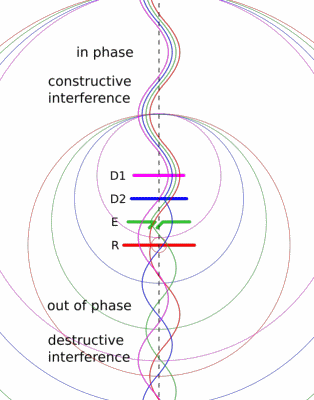5 Dangers of Radio Waves and their Implications Discussed
Dangers of radio waves are; thermal damage of biological tissue, signal interference and disruption, cancer risk exacerbation, flora and fauna mutagenesis, and health symptoms like fatigue and headache
This article discusses the dangers of radio waves, and their implications, as follows;
1). Thermal Damage of Biological Tissue (as one of the Dangers of Radio Waves)
One of the negative effects of radio waves on humans is concerned with potential damage of body tissues.
Radio waves affect the human body because of their ability to penetrate tissues, and their thermal energy content.
While the heat from radio waves is not instantaneously high, prolonged exposure of tissues in the body, to these waves, can cause a build-up of heat which can lead to significant thermal alteration.
Generally, types of radiation that have been found to have a heating effect on body tissues include microwaves and radio waves. These two are similar in wavelength and frequency, among other characteristics.
The wavelength and frequency of radio waves play a role in their use in communication devices. Because radio waves have long wavelength and low frequency, they are non-ionizing, and unlikely to affect humans with the same severity as x rays and ultraviolet radiation.
However, using radio waves for wireless transfer of information between smart devices like mobile phones, can lead to prolonged exposure with harmful consequences.
Thermal damage of tissues by radio waves has been observed to affect various parts of the body including eye lens, white and grey brain tissues [1].
2). Signal Interference and Disruption
One of the dangers of radio waves in communication is signal interference and the resultant disruption of communication routes between information systems.
Destructive interference affects radio waves by leading to signal losses and/or low quality reception. It occurs when multiple radio wave signals are vibrating at equal frequency within the same region or space, so that these signals can no longer be distinctly decoded by receiver.
The problem with radio frequency interference is its effect on communication and information-transmission. Interference and disruption can have particularly fatal consequences when they occur in systems used for purposes like transport and healthcare; with examples including cases of automobile accidents caused by poor reception of GPS navigation signals.
Radio communication can be disrupted deliberately by induced radio frequency interference (RFI, EMI); which can be achieved by transmitting an equivalent-frequency stream of radio waves into a communication network. Such measures are applicable where there is need to prevent communication for security purposes.

3). Cancer Risk-Exacerbation (as one of the Dangers of Radio Waves)
Cancer risk-exacerbation is another example of the negative effects of radio waves on humans.
Generally, the types of EM waves that can cause cancer and cell damage on overexposure, are mostly ionizing waves like gamma rays and x-rays, which are capable of altering the chemical structure of DNA in the body.
Although radio waves are not classified as ionizing radiation, studies have revealed an apparent correlation between radio wave overexposure and high risk of various kinds of cancer, including mammary and dermal cancers. These observations have formed the basis on which to describe radio waves as being carcinogenic.
It is important to note that this does not necessarily imply that radio waves directly contribute to cancer incidents; as there is yet limited evidence to prove a direct link between the two. Rather, it places radio waves among the possible contributors to cancer, which is classified as Group 2B on a scale of carcinogenicity [4].
Some criteria which have been used to study the potential role of radio waves in cancer incidents include the rate of development of mammary tumors, sarcoma colonies in the lung, hepatomas, and skin tumors [6].
4). Flora and Fauna Mutagenesis
Mutagenesis is simply the development of genetic mutations in living organisms.
The mechanism of mutagenesis is in fact what leads to cancer development in humans, on exposure to ionizing electromagnetic radiation.
The ability of ionizing radiation to cause genetic mutation in plants and animals has been utilized in the agricultural sector to produce new genetic strains of crops, with desirable characteristics [3].
Studies have also shown that prolonged exposure to non-ionizing radiations like microwaves (and radio waves) is also a potential cause of mutagenesis in flora and fauna [7].
This is considered a danger because it can cause undesirable genetic modifications in exposed organisms.
5). Ill-Health Symptoms (as one of the Dangers of Radio Waves)
In addition to its other effects on humans, exposure to radio waves can induce a number of ill-health symptoms in the human body.
Radio waves can affect the brain on overexposure, leading to neurological and cognitive problems like dizziness, headache, insomnia, tinnitus, loss of concentration and memory, and tremors [2]. These symptoms can summarily be described as microwave syndrome, EMF sickness, or Electromagnetic Hypersensitivity (EHS) [5].
As earlier stated, symptoms of EMF sickness include cognitive disorders like sleep disturbance, fatigue, headache, stress, depression, numbness and nausea. Other symptoms may be sensory and physiological, like; dysesthesia, muscle pain, prickling sensations, and rashes.
These effects can contribute to health decline and poor metabolic functioning.
Conclusion
Dangers of radio waves are;
1. Thermal Damage of Biological Tissue
2. Signal Interference and Disruption
3. Cancer Risk-Exacerbation
4. Flora and Fauna Mutagenesis
5. Constellation Symptoms
References
1). Forouharmajd, F.; Pourabdian, S.; Ebrahimi, H. (2018). "Evaluating Temperature Changes of Brain Tissue Due to Induced Heating of Cell Phone Waves." International Journal of Preventive Medicine 9(1):40. Available at: https://doi.org/10.4103/ijpvm.IJPVM_393_16. (Accessed 30 March 2023).
2). Kim, J. H.; Lee, J. K.; Kim, H. G.; Kim, K. B.; Kim, H. R. (2019). "Possible Effects of Radiofrequency Electromagnetic Field Exposure on Central Nerve System." Biomol Ther (Seoul). 2019 May 1;27(3):265-275. Available at: https://doi.org/10.4062/biomolther.2018.152. (Accessed 30 March 2023).
3). Ma, L.; Kong, F.; Sun, K.; Wang, T.; Guo, T. (2021). "From Classical Radiation to Modern Radiation: Past, Present, and Future of Radiation Mutation Breeding." Front Public Health. 2021 Dec 21;9:768071. Available at: https://doi.org/10.3389/fpubh.2021.768071. (Accessed 30 March 2023).
4). Mevissen, M.; Ward, J. M.; Kopp-Schneider, A.; McNamee, J. P.; Wood, A. W.; Rivero, T. M.; Thayer, K.; Straif, K. (2022). "Effects of radiofrequency electromagnetic fields (RF EMF) on cancer in laboratory animal studies." Environ Int. 2022 Mar;161:107106. Available at: https://doi.org/10.1016/j.envint.2022.107106. (Accessed 30 March 2023).
5). Mohammadianinejad, S. E.; Babaei, M.; Nazari, P. (2016). "The Effects of Exposure to Low Frequency Electromagnetic Fields in the Treatment of Migraine Headache: A Cohort Study." Electron Physician. 2016 Dec 25;8(12):3445-3449. Available at: https://doi.org/10.19082/3445. (Accessed 30 March 2023).
6). Repacholi, M. H. (1997). "Radiofrequency field exposure and cancer: what do the laboratory studies suggest?" Environ Health Perspect. 1997 Dec;105 Suppl 6(Suppl 6):1565-8. Available at: https://doi.org/10.1289/ehp.97105s61565. (Accessed 30 March 2023).
7). Upadhyaya; C.; Upadhyaya, T.; Patel, I. (2022). "Exposure effects of non-ionizing radiation of radio waves on antimicrobial potential of medicinal plants." Journal of Radiation Research and Applied Sciences, Volume 15, Issue 1, March 2022, Pages 1-10. Available at: https://www.sciencedirect.com/science/article/pii/S1687850722001091. (Accessed 30 March 2023).




